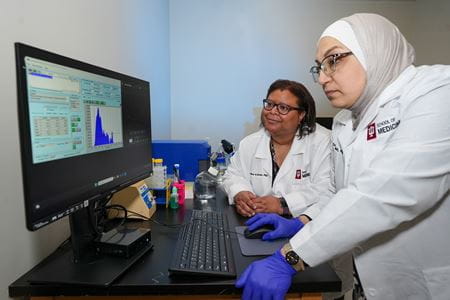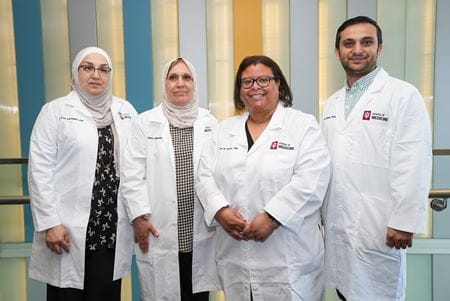An intricate network of blood vessels — called the brain’s vasculature — delivers oxygen and nutrients to billions of neurons, the building blocks of the central nervous system.
Neurons cannot function without a healthy brain, and a disruption in the flow of blood to the brain could result in stroke and lead to neurodegeneration or other neurological conditions.
“A lot of neuroscientists are studying aspects of cerebrovascular research — they just don’t realize it,” Candice Brown, PhD, said. “If you're studying neurons, you're indirectly studying how the brain’s vasculature influences the neuronal environment and neuronal function. It’s a common thread between Alzheimer's disease, addiction, pain and spinal cord injury research.”
Brown, an associate professor of anesthesia and neurology, joined the Indiana University School of Medicine in February 2025 to grow the school’s neurovascular and cerebrovascular basic science and clinical research. Her laboratory, which relocated from the West Virginia University School of Medicine, focuses on cerebrovascular research, specifically how stroke and inflammatory conditions and infections may contribute to Alzheimer’s disease and dementia.
Collaboration among IU scientists and clinicians
 As the director of neurovascular research within the Center for Neurovascular Disorders in the IU School of Medicine-IU Health Neuroscience Institute, Brown is working with Richard Scheer, MD, the interim director of the center, and other vascular neurologists in the Department of Neurology to develop a robust translational cerebrovascular and stroke research program.
As the director of neurovascular research within the Center for Neurovascular Disorders in the IU School of Medicine-IU Health Neuroscience Institute, Brown is working with Richard Scheer, MD, the interim director of the center, and other vascular neurologists in the Department of Neurology to develop a robust translational cerebrovascular and stroke research program.
The team is leveraging the unique partnership between basic scientists from Stark Neurosciences Research Institute in the IU School of Medicine’s Neurosciences Research Building and clinicians in the outpatient IU Health Neuroscience Center. The two six-level buildings are connected as one state-of-the-art neuroscience hub in downtown Indianapolis.
“It promotes excellent interactions between basic and clinical researchers, so translational research is really critical,” Brown said, who has helped lead large research grants and training programs at past institutions. “I thought that's a place where I would love to be.”
Brown’s expertise in cerebrovascular research complements the clinical work of stroke specialists in the Department of Neurology. The growing specialty includes nine physicians and physician-scientists and one fellow; the department plans to add a second fellow in vascular neurology for the 2026-27 academic year.
Scheer, assistant professor of clinical neurology, said Brown is integral to the growth of the department’s cerebrovascular/stroke program and the Center for Neurovascular Disorders. Brown, Scheer and other center leaders have begun their strategic planning process to identify cerebrovascular researchers and grow the center’s basic, translational and clinical research.
“Dr. Brown is already leading cutting edge research in neurovascular disease, and we are very excited about collaborating with her,” Scheer said. “It will be her vision and expert insight that shapes the strategy for future basic, translational and clinical neurovascular research at IU.”
Connecting vascular and neurodegenerative disorders
According to the U.S. Centers for Disease Control and Prevention, nearly 800,000 people experience a stroke each year in the United States, and it’s the fifth leading cause of death. About 87% of all strokes are ischemic, which is when the blood flow to the brain is blocked.
When a person experiences a stroke or a heart attack, the flow of blood and oxygen to the brain is damaged. Researchers believe vascular diseases can impact a person’s memory and thinking skills, potentially causing dementia or Alzheimer’s disease. Brown studies this phenomenon, called vascular contributions to cognitive impairment and dementia, or VCID.
“Recent studies have found that having a stroke doubles the risk of developing dementia,” Brown said. “Although strokes commonly occur in older populations, the risk of stroke in younger populations in their 30s and 40s is increasing due to stroke risk factors like obesity, hypertension and diabetes. This means there could be an earlier onset of dementia or more severe in this population.”
Brown and her research team are also investigating how sepsis — when the body’s response to an infection damages its tissues and organs — can cause VCID. More than 1.7 million people in the U.S. each year develop sepsis, and most also have an underlying medical condition.
The research team found that sepsis is more severe in Alzheimer’s disease animal models, and these infections could lead to further brain dysfunction and neuroinflammation.
Brown is specifically studying two mechanistic links — an enzyme found in blood and tiny particles released by cells — could shed light on why stroke and sepsis lead to VCID.
The enzyme, called alkaline phosphatase, is commonly found in all cells, but for reasons that are not understood, she said, it is highly active in the brain's vasculature. For the past several years, her lab team has been studying the enzyme’s impact on stroke and sepsis.
They found that the level of alkaline phosphatase decreases in the brains of animal models after stroke and sepsis and in animal models of Alzheimer’s disease. They also determined that the loss of the enzyme predisposes animal models to brain bleeds, neuroinflammation and sensorimotor deficits after stroke, which may potentially lead to VCID, Brown said.
"We believe that the presence of alkaline phosphate in brain blood vessels protects the blood-brain barrier and hence the rest of the brain following brain injury,” Brown said. “From a therapeutic standpoint, one way to protect the brain following stroke and other types of brain injury is to increase the levels of alkaline phosphatase enzyme in brain blood vessels."
The other mechanistic link studied by Brown are extracellular vesicles, a way cells communicate. These vesicles are tiny particles released during injury and disease and fuse with cells in other organs.
“It's a way to deliver information from one cell and cell type to another without them actually interacting,” Brown said. “We're trying to figure out what is released inside of these vesicles during stroke or during sepsis and can we use what’s inside of them as a biomarker to predict who might be at risk of developing diseases like VCID later in life.”
